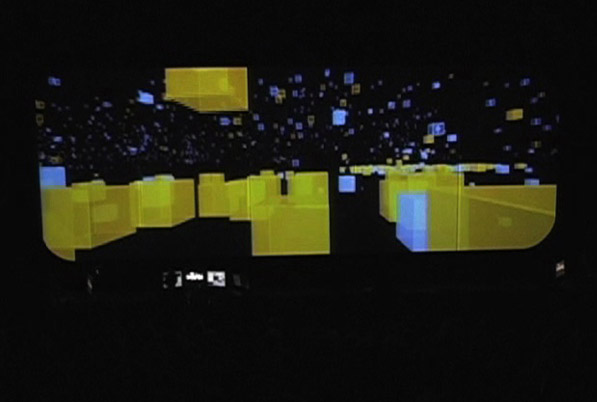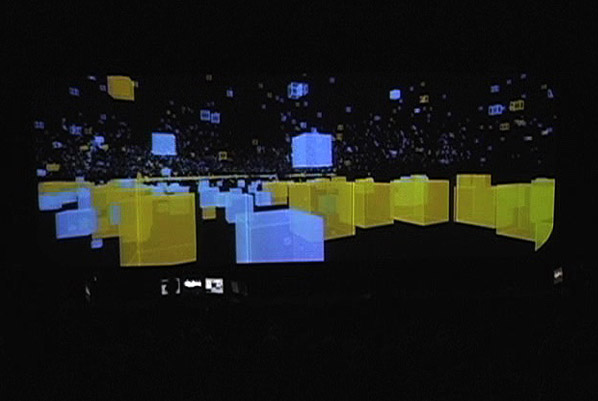The Builders Association and dbox, SUPER VISION: STORY
SUPER VISION tells three stories
1. As he crosses successive borders, a solitary traveller gradually is forced to reveal all of his personal information, until his identity becomes transparent, with no part of his life left outside the boundaries of datasurveillance.
2. A young woman (Jen), addicted to the white noise of constant connection, maintains a long-distance relationship with her Grandmother. As she makes efforts to digitally archive her Grandmother's past, the Grandmother slips into senility.
3. A father covertly exploits his young son's personal data to meet the demands of the family's lifestyle. This ploy escalates beyond the father's control, until he is compelled to disappear. His wife and son are left with a starkly diminished data portrait, and his escape is shadowed by the long reach of the datasphere.
Constance DeJong: I wanted the sense that the three stories were interwoven, not going 1, 2, 3 - 1, 2, 3 - 1, 2, 3. The structure had another element added to it, which became these visual interludes that James Gibbs and dbox made where all the front screens are closed across the stage and there are these more virtual, visual moments which add another possibility for sequencing the scenes. For either keeping the flow or changing the tempo or variegating the sequential nature of theatre, so that you don’t feel you are in a 1, 2, 3 - 1, 2, 3 locked step with the stories.
Constance DeJong: I ended up finding that inclusion of the stage projection very important to this structuring of the story arcs, because they brought in yet another motif and respite for the house. You kind of left one story and re-entered another, as opposed to having the two stories bang up against each other, which we tried. We tried a different kind of flow. What I feel about the structure now is that flow is achieved through this synchronicity of sound and image - speech drops aside, another scene comes on. That there is a continuous flow to the piece.
Nick Kaye: James Gibbs suggested, in his dialogue with Marianne Weems at the Brooklyn Academy of Music– and I am paraphrasing him - ‘that the show uses the tools that it critiques’. That comes across very strongly in what you’re saying - that the performance is articulated through the processes it addresses.
Rizwan Mirza: That is true. We can’t remove ourselves from it. It has become so necessary for us to even express ourselves. It is interesting, though, that when we were first workshopping the show the technology wasn’t there. I think that is testimony to the fact that these stories are strong on their own – that the concept is already strong on its own. It does not rely on the smoking mirrors or the glitter of the technology to make this shine. The same thing happened in ALLADEEN. We started with desks and hand held microphones. There were no projections. In SUPER VISION, I think my particular story is very clear. It is layered, but you know what is going on. It is concise - people can relate to it very quickly. They know they have seen this before. They have points of references from past two years - with what is happening not just in America, but all over the world. We are not far from what we portray in this show.
see also: narrative | the traveller |


'Data' animations. Video stills.
